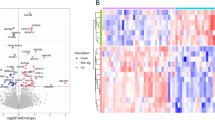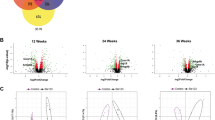Abstract
Background
Minimal-change nephrotic syndrome is an idiopathic disease in which protein leaks through podocytes into the urine. We used proteomic tools to examine differences of plasma protein expression in healthy rats and rats with doxorubicin-induced nephropathy treated with or without prednisone.
Methods
Healthy three-month-old Sprague–Dawley male rats were randomly chosen for one injection of doxorubicin (5.5 mg/kg) through the caudal vein to induce nephropathy (n = 50) or the same volume of saline (control, n = 20). After 1 week, 25 rats in the nephropathy group received topical prednisone (5.5 mg/kg/day) for 21 days and another 25 rats (untreated nephropathy) and the control rats received topical water. At 4 weeks, protein chips generated from rat plasma samples were analyzed by surface enhanced laser desorption/ionization–time of flight mass spectrometry (SELDI–TOF–MS) to obtain mass-to-charge ratios (m/z) of proteins of 2–50 kDa.
Results
Relative to control rats, untreated nephropathic rats had four significantly higher and seven significantly lower m/z peaks. Prednisone treatment significantly normalized the intensities of peaks 9069 and 15005 (which correspond to cortexin-1 and interleukin-17A, respectively, according to Swiss Prot database) by increasing the expression of 9069 but reducing expression of 15005.
Conclusion
Significant differences in plasma proteins can be identified by proteomic analysis using SELDI–TOF–MS in a rat model of nephropathy.





Similar content being viewed by others
References
Lane JC, Kaskel FJ. Pediatric nephrotic syndrome: from the simple to the complex. Semin Nephrol. 2009;29:389–98.
Cameron JS, Turner DR, Ogg CS, Sharpstoner P, Brown CB. The nephrotic syndrome in adults with ‘minimal change’ glomerular lesions. Q J Med. 1974;43:461–88.
He K, Li R. Analysis on wean refractory nephropathy. Chin J Pract Integr Med. 2004;4:2621–2.
Yue Z, Min W, Qian W, Fei C, Jing Y, Boguang L, et al. Study on the establishment of the model of minimal change nephropathy with adriamycin in rats. J Beijing Univ TCM. 2002;3:16–8.
Traum AZ, Schachter AD. Proteomic analysis in pediatric renal disease. Semin Nephrol. 2007;27:652–7.
Yoshida Y, Miyamoto M, Bo X, Yaoita E, Yamamoto T. Overview of kidney and urine proteome databases. Contrib Nephrol. 2008;160:186–97.
Gorg A, Weiss W, Dunn MJ. Current two-dimensional electrophoresis technology for proteomics. Proteomics. 2004;4:3665–85.
De Bock M, de Seny D, Meuwis MA, Chapelle JP, Louis E, Malaise M, et al. Challenges for biomarker discovery in body fluids usingSELDI–TOF-MS. J Biomed Biotechnol. 2010;2010:906082.
Merchant ML, Klein JB. Proteomics and diabetic nephropathy. Semin Nephrol. 2007;27:627–36.
Yoshida Y, Miyazaki K, Kamiie J, Sato M, Okuizumi S, Kenmochi A, et al. Two-dimensional electrophoretic profiling of normal human kidney glomerulus proteome and construction of an extensible markup language (XML)-based database. Proteomics. 2005;5:1083–96.
Miyamoto M, Yoshida Y, Taguchi I, Nagasaka Y, Tasaki M, Zhang Y, et al. In-depth proteomic profiling of the normal human kidney glomerulus using two-dimensional protein prefractionation in combination with liquid chromatography-tandem mass spectrometry. J Proteome Res. 2007;6:3680–90.
Oh J, Pyo JH, Jo EH, Hwang SI, Kang SC, Jung JH, et al. Establishment of a near-standard two-dimensional human urine proteomic map. Proteomics. 2004;4:3485–97.
Pieper R, Gatlin CL, McGrath AM, Makusky AJ, Mondal M, Seonarain M, et al. Characterization of the human urinary proteome: a method for high-resolution display of urinary proteins on two dimensional electrophoresis gels with a yield of nearly 1400 distinct protein spots. Proteomics. 2004;4:1159–74.
Khan A, Packer NH. Simple urinary sample preparation for proteomic analysis. J Proteome Res. 2006;5:2824–38.
Pisitkun T, Shen RF, Knepper MA. Identification and proteomic profiling of exosomes in human urine. Proc Natl Acad Sci USA. 2004;101:13368–73.
Hawkridge AM, Muddiman DC. Mass spectrometry-based biomarker discovery: toward a global proteome index of individuality. Annu Rev Anal Chem. 2009;2:265–77.
Sparbier K, Wenzel T, Dihazi H. Immuno-MALDI–TOF MS, new perspectives for clinical applications of mass spectrometry. Proteomics. 2009;9:1442–50.
Hutchens T, Yip T. New desorption strategies for the mass spectrometric analysis of macromolecules. Rapid Commun Mass Spectrom. 1993;7:576–80.
Jr GW, Cazares LH, Leung SM, Nasim S, Adam BL, Yip TT, et al. ProteinChip® surface enhanced laser desorption/ionization (SELDI) mass spectrometry: a novel protein biochip technology for detection of prostate cancer biomarkers in complex protein mixtures. Prostate Cancer Prostatic Dis. 1999;2:264–76.
Wright GL Jr. SELDI protein chip MS: a platform for biomarker discovery and cancer diagnosis. Expert Rev Mol Diag. 2002;2:549–63.
Tang N, Tornatore P, Weinberger SR. Current developments in SELDI affinity technology. Mass Spectrom Rev. 2004;23:34–44.
Zhao H, Ljungberg B, Grankvist K, Rasmuson T, Tibshirani R, Brooks JD. Gene expression profiling predicts survival in conventional renal cell carcinoma. PLoS Med. 2006;3:e13.
Oberthuer A, Berthold F, Warnat P, Hero B, Kahlert Y, Spitz R, et al. Customized oligonucleotide microarray gene expression-based classification of neuroblastoma patients outperforms current clinical risk stratification. J Clin Oncol. 2006;24:5070–8.
Liu LL, Qin Y, Cai JF, Wang HY, Tao JL, Li H, et al. Th17/Treg imbalance in adult patients with minimal change nephrotic syndrome. Clin Immunol. 2011;139:314–20.
Matsumotoa K, Kanmatsuse K. Increased urinary excretion of interleukin-17 in nephrotic patients. Nephron. 2002;91:243–9.
Puppione DL, Ryan CM, Bassilian S, Souda P, Xiao X, Ryder OA, et al. Detection of two distinct forms of apoC-I in great apes. Comp Biochem Physiol Part D Genomics Proteomics. 2010;5:73–9.
Arystarkhova E, Wetzel RK, Sweadner KJ. Distribution and oligomeric association of splice forms of Na+-K+-ATPase regulatory gamma-subunit in rat kidney. Am J Physiol Renal Physiol. 2002;282:393–407.
Breiteneder-Geleff S, Matsui K, Soleiman A, Meraner P, Poczewski H, Kalt R, et al. Podoplanin, novel 43-kd membrane protein of glomerular epithelial cells, is down-regulated in puromycin nephrosis. Am J Pathol. 1997;151:1141–52.
Gonzalez E, Neuhaus T, Kemper MJ, Giradin E. Proteomic analysis of mononuclear cells of patients with minimal-change nephrotic syndrome of childhood. Nephrol Dial Transplant. 2009;24:149–55.
Bertani T, Poggi A, Pozzoni R, Delaini F, Sacchi G, Thoua Y, et al. Adriamycin-induced nephrotic syndrome in rats: sequence of pathologic events. Lab Invest. 1982;46:16–23.
Bricio T, Molina A, Egido J, Gonzalez E, Mampaso F. IL-1-like production in adriamycin-induced nephrotic syndrome in the rat. Clin Exp Immunol. 1992;87:117–21.
Ishikawa I, Hayama T, Yoshida S, Asaka M, Tomosugi N, Watanabe M, et al. Proteomic analysis of rat plasma by SELDI–TOF-MS under the condition of prevention of progressive adriamycin nephropathy using oral adsorbent AST-120. Nephron Physiol. 2006;103:125–30.
Hammer E, Bien S, Salazar MG, Steil L, Scharf C, Hildebrandt P, et al. Proteomic analysis of doxorubicin-induced changes in the proteome of HepG2cells combining 2-D DIGE and LC-MS/MS approaches. Proteomics. 2010;10:99–114.
Chen Y, Daosukho C, Wycliffe O, Turner DM, Pierce WM, Klein JB, et al. Redox proteomic identification of oxidized cardiac proteins in Adriamycin-treated mice. Free Radic Biol Med. 2006;41:1470–7.
Coulter PM 2nd, Bautista EA, Margulies JE, Watson JB. Identification of cortexin: a novel, neuron-specific, 82-residue membrane protein enriched in rodent cerebral cortex. J Neurochem. 1993;61:756–9.
Wang HT, Chang JW, Guo Z, Li BG. In silico-initiated cloning and molecular characterization of cortexin 3, a novel human gene specifically expressed in the kidney and brain, and well conserved in vertebrates. Int J Mol Med. 2007;20:501–10.
Chakraborty S, Khan GA, Karmohapatra SK, Bhattacharya R, Bhattacharya G, Sinha AK. Purification and mechanism of action of “cortexin”, a novel antihypertensive protein hormone from kidney and its role in essential hypertension in men. J Am Soc Hypertens. 2009;3:119–32.
Kontchou LM, Liccioli G, Pela I. Blood pressure in children with minimal change nephrotic syndrome during oedema and after steroid therapy: the influence of familial essential hypertension. Kidney Blood Press Res. 2009;32:258–62.
Gipson DS, Massengill SF, Yao L, Nagaraj S, Smoyer WE, Mahan JD, et al. Management of childhood onset nephrotic syndrome. Pediatrics. 2009;124:747–57.
LaBaer J. So, you want to look for biomarkers? J Proteome Res. 2005;4:1053–9.
Knepper MA. Common sense approaches to urinary biomarker study design. J Am Soc Nephrol. 2009;20:1175–8.
Acknowledgments
The study was supported by the Natural Science Foundation of Fujian (project numbers 2007J0307, 2008J0093).
Conflict of interest
The authors have declared that no conflict of interest exists.
Author information
Authors and Affiliations
Corresponding author
About this article
Cite this article
Ai, S., Zheng, J., Lin, Q. et al. Proteomic analysis indicates altered expression of plasma proteins in a rat nephropathy model. Clin Exp Nephrol 17, 24–31 (2013). https://doi.org/10.1007/s10157-012-0662-y
Received:
Accepted:
Published:
Issue Date:
DOI: https://doi.org/10.1007/s10157-012-0662-y




